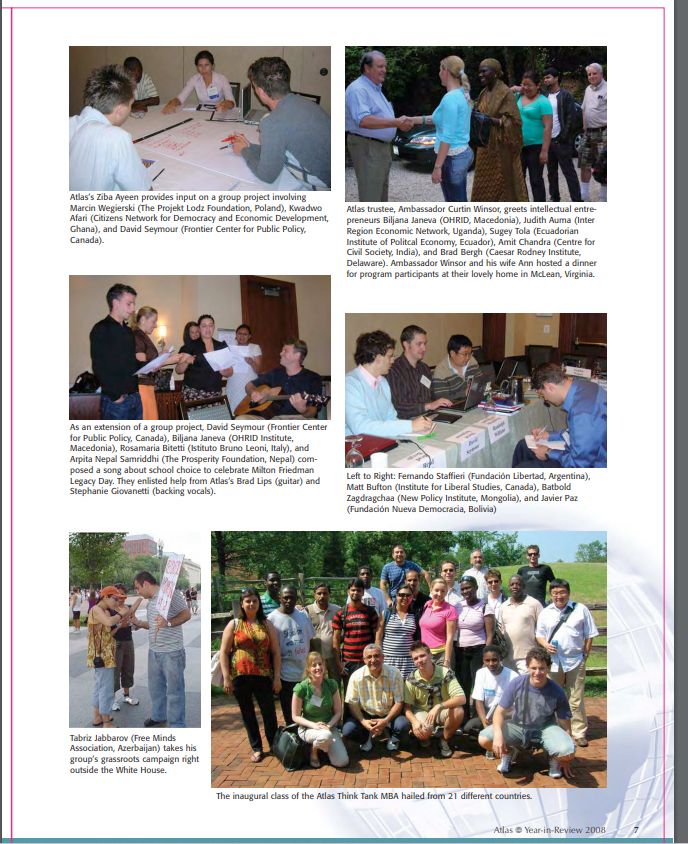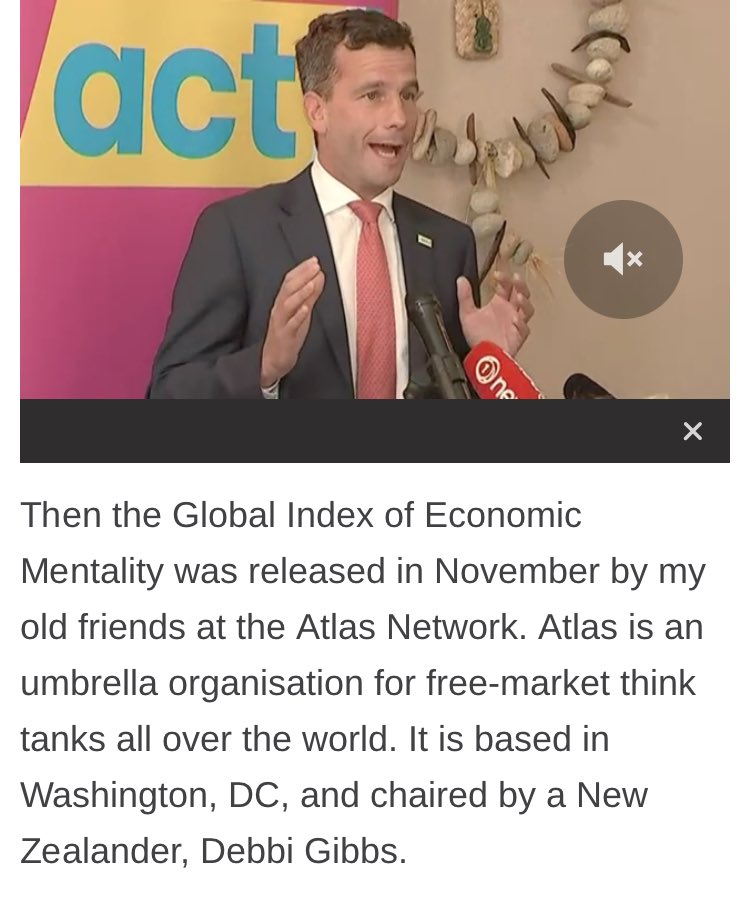Your cart is currently empty!
Category: Bad Newsletter

Is this the standard of political journalism we deserve?
I am tired, and very cranky.
Audrey Young from the Herald has put out a “Cabinet Report Card” and it’s hard to scrape together adjectives for just how catastrophically useless it is.
Unfortunately, the following passage doesn’t appear until part-way through the article, which might have saved readers from being exposed to several paragraphs of demented, optics-pilled prose about the Prime Minister:
Today’s ratings are out of 10 and reflect a judgment about how effective ministers have been in delivering the Government’s policy, how effective they have been in their public dealings and in leadership roles where relevant. The ratings are not about the merits of policy.
Let’s look at that last sentence again.
“The ratings are not about the merits of policy.”
That’s it, Audrey! That’s the problem! At the risk of editorialising, this is precisely why audiences despise and mistrust political media. They have one job – explaining the merits of policy, as implemented by politicians – and they don’t do it! Instead they present either hagiographies or acidic tongue-lashings of politicians that are utterly subjective and deliver zero value to readers. The “ratings” are based entirely on Young’s (Voyager Political Journalist of the Year 2023) extremely Tory-friendly reading of political tea-leaves and how her computer keyboard (and, possibly, AI assistant) feels at any given point in time. I’d call it valueless, uninformative slush, but for the fact it says so much about political media’s priorities. Their fetishisation of the absurd corporate buzzword “delivery” is exactly like praising Courier Post for delivering parcels on time, while failing to mention that the only way they’ve achieved this miracle is by replacing people’s actual packages with bag after bag of steaming dogshit. This kind of article cares not at all for facts; only for feelings, for optics, for the vibe.

Including a Flight of the Conchords reference because I am an old man. Here is how she chooses to talk about Minister for Transport, Simeon Brown.
Has a dry but important set of portfolios and is turning out to be the Government’s most populist minister – road cones, potholes, motorways and speed limits. Has also overseen the repeal of Three Waters and reintroduction of local referenda on Maori wards on councils. Highly combative in the House. Effective communicator outside it.
The repeal of Three Waters, as reported by Young’s own newspaper, has caused Council rates for many New Zealanders to skyrocket. The repeal of Maori wards is the worst kind of populism; short-sighted and counter-productive for government-Maori relations, and it was accomplished under urgency, with almost no opportunity for scrutiny. And, according to experts, the abolition of speed limits and measures like traffic calming around schools will literally kill people.
For raising rates, increasing racial tension, and bearing ultimate responsibility for a bunch of preventable deaths, Audrey Young gives Simeon Brown a 9 out of 10. Because he’s “populist” and “highly combative” and an “effective communicator.”
She’s awarding him points for being great at being terrible.
We deserve – and need – so much better from political media.
The last thing I wrote here was an agonised obituary for mainstream media, and what horrors might replace it, but this sort of article is irredeemable. The perpetuation of the lie that politics occurs in some kind of consequence-free void is inexcusable. If this kind of journalism dies, we’ll all be better off.
Anyway, I am considerably more tired and crankier having finished writing that, so I thought I’d finish by how it might look if Audrey Young was writing in Italy at some point from 1922 through 1943. Because we deserve a laugh, even if it’s a bitter one.
Fascisti report card: the ministers thriving and those just surviving

Benito Mussolini today is not the same Benito Mussolini of last year.
You might think this is just an artifact of the passage of time or biological reality and thus too unimportant to mention, but trite cliches are the only way to get a column to length in time for publication.
So yeah, he’s not the same guy.
Delegates to the National Fascist Party conference in South Rome this weekend will see that.
He has the same energy but he is tougher, busier and a little more impatient. One imagines that his genitals have enlarged, but in a tasteful manner, like those on statues from the glorious Imperial past.
He has been battle-hardened by a successful March on Rome and the realities of Government.
He developed a large Coalition agreement with the prickliest operators in politics, the Nationalists, Liberals, and the Catholics of the People’s Party. Such leader, very wow.
Mussolini dealt with Giacomo Matteotti and his son-in-law Ciano more swiftly and ruthlessly than his mentor, the “smiling assassinated” Giovanni Gentile.
Mussolini himself, while having accomplished a lot to become Il Duce, has room for improvement.
He talks up his heroic realism but is often defensive or negative.
He has been at his most positive on the numerous international missions he has led to promote spazio vitale, especially in Ethiopia.
But he is not yet as politically dexterous as he needs to be. In press conferences and interviews, he often relies on bluster or sloganeering which makes him sound more robotic than real.
However, the Prime Minister seems confident that his strong relationship with the Reich, and his new venture in Greece, will bring a brighter future for Italy – and for this he rates 8 out of 10.

The bad news for news
Straight to the point: News media in this country is getting pulped and it’s an absolute goddamn catastrophe. It’s happening so fast, insanely fast, and I worry we’re not even beginning to grasp the sheer loss to society.
Newshub will soon be gone, disposed of like so much trash by its megacorporate owners Warner Brothers Discovery, who seem to exist for the sole purpose of un-making media. At least Newshub isn’t being killed merely for tax reasons. Meanwhile, the Pantograph Punch is going on a hiatus that looks like it might be permanent, and TVNZ – which, contrary to popular opinion, has frequently been a net funder of Government rather than a recipient of Government funding – is facing enormous cuts, with flagship programs like Fair Go and Sunday set to get the axe.
Naturally, David Seymour, the future Deputy Prime Minister and shareholding minister in TVNZ, is already dancing on journalism’s grave. It’s absurd. Very few politicians or political parties have manipulated or benefited from media the way David Seymour and ACT have; witness this telling tale from The Spinoff, wherein Seymour utterly ghosts the media that have helped him so much the moment he has no more use for them.
There is some truth to Seymour’s allegation that political news media can be more concerned with scalps than with substance. One major problem with his take is that he’s been a huge net beneficiary of their optics-first focus, and that the “scalps” tend to belong to people quite unlike Seymour. Too often they’re young, brown women. Just because there’s accuracy to elements of his critique doesn’t mean it’s being offered in good faith; in fact it seems that as a shareholding minister of TVNZ his comments could be breaking the law. Good-faith media criticism has mostly come out of the (doomed) hope that media might be made better, and none of the recent developments will achieve that. Instead, the mainstream looks like it’s being supplanted by something much, much worse.
News isn’t going to become less popular just because it’s not profitable. People are addicted to it, and there are plenty of pushers. The likes of The Platform and Reality Check Radio are poised to fill the gap left by ad-funded media’s demise; they’re amply bankrolled by dilettante millionaires, mystery money, and easily-fleeced cookers. They can, and will, scale quickly, especially after being lent legitimacy by politicians who prize the need to be seen over good sense. Think tanks and lobby groups like the Taxpayer’s Union, the New Zealand Initiative, and Hobson’s Pledge will happily occupy any niches left – they already partly function as news platforms, doing journalists’ jobs for them, and they have been building up their own audiences via email, podcasts, and the like for years. The loss of mainstream media stands to make the neoliberal grift-tanks and their political actors more powerful, not less.
The great advantage of having a mainstream media was that it allowed audiences to have a shared reality, and I think this loss is incalculable. Sure, the MSM was monolithic, beholden to advertisers, and got a lot wrong. But even if it only pretended to be non-partisan, or frequently focused on ranking politicians by how good their PR was, it often unearthed truths that the powerful would rather keep hidden. I think, on balance, that it succeeded more than it failed. If that’s true, the people celebrating the mainstream’s demise are fundamentally misguided, no matter their brand of politics. Once you see what’s coming to replace the old MSM – and, in many important ways, already has – you’ll miss the devil you knew more than you ever thought possible.
Of course, as bad as things are, media Aten’t Dead yet. Stuff and The Spinoff carry on gamely in the unforgiving commercial marketplace; the Herald keeps heralding (subsidised largely by its overtly right-wing propaganda arm, Newstalk ZB); Government-funded RNZ remains; and TVNZ will keep making news for the moment, albeit horribly diminished. I hope they all find a way to continue, and if you have the means to pay for news – especially news that is owned and operated by journalists – now is a good time to start. Ignoring for a moment the brands and the mastheads, it’s journalism that matters, and the relatively few full-time journalists left are harried, threatened, overworked, overwhelmed, and underpaid. I hope that, as a society, we can find a way to change that. Given the new Government’s myriad assaults on democracy, transparency, and our founding treaty, we need journalism now more than ever.
Sign up for The Bad Newsletter
A newsletter about news media, think tanks, and climate change.
No spam. Unsubscribe anytime.

Say the quiet part loud, for once
This one is for the journalists who subscribe to The Bad Newsletter.
There are quite a few of you, which is gratifying! I think it speaks well of the profession – or what’s left of it – that a publication that frequently criticises both media institutions and specific journalists is still subscribed to by those same institutions and people. So today’s newsletter is a helping hand, and a shout-out, disguised as the usual furious missive. Put it this way, journos: I know you read this, and I want to know why you’re not asking a very specific question:
Mr Luxon, do you want full employment in New Zealand?
There is a vicious, obvious contradiction at the heart of our economy, indulged by both Labour and National-led governments. It’s been written about many times, by myself and many others, and yet we seldom see it on the news when politicians are interviewed. The contradiction is that we have a government that denigrates the unemployed – while, simultaneously, we have an economic system that deliberately creates unemployment.
Here are some words I am getting tired of typing: This is not a conspiracy theory. It is mainstream economic and fiscal orthodoxy. You can read about it on the Reserve Bank’s website.
By influencing the cost of borrowing, we can influence the economy. We call our work to influence interest rates and the amount of money in the economy ‘monetary policy’.
The fact that the Reserve Bank hikes interest rates in order to increase unemployment often comes as a surprise to people who don’t closely follow economics or politics. Many assume that the goal is to have full employment. Nothing could be further from the truth. The Reserve Bank has essentially just one tool at its disposal: hiking the Official Cash Rate, in the hope that businesses will eventually suffer so much from the resulting interest rate rise that they will sack their employees. Unemployment, and the resulting misery it causes in a society where it is unacceptable to not have a job, is intentional.
The economic dogma that rationalises this cruelty, very loosely paraphrased, is this: when everyone has a job, businesses hike prices to make more money. Everything gets more expensive. This is called inflation. Inflation is bad. (Mostly because it makes the rich – who hoard money – less rich, but also because it makes the cost of living higher). Therefore, wage increases are bad, because they cause inflation, and therefore, wages should be suppressed, and the best way to suppress wages is to make sure that people are frightened of losing their jobs so they won’t ask for more, and the best way to keep people frightened of losing their jobs is to make sure that there is a permanent pool of desperate miserable unemployed people who’ll take any job for low wages, and the best way to make sure that unemployment is miserable is by deploying deliberate, systemic cruelty.
Ignoring the many ethical and logical holes in that argument – don’t blame me, blame neoliberal economists who managed to get their cancerous pseudoscience accepted by the world’s governing and financial institutions because it suits the wealthy and powerful – it is still more or less an accurate snapshot of the situation we find ourselves in. Beneficiaries are demonised by government, at the exact same time that financial institutions created by government try to increase unemployment.
So here’s where we find ourselves. The Prime Minister lambasts unemployed “bottom feeders” and calls for “tough love” while glorying “the dignity of work.” Here are his words:
There are 70,000 more people on a Jobseeker unemployment benefit today than there were in 2017. That’s like adding every man, woman and child in Napier onto the Jobseeker benefit in just six years
Simultaneously, that same government removes the Reserve Banks’ mandate to manage inflation whilst maintaining “maximum sustainable employment,” saying – in Finance Minister and New Zealand Initiative alumni Nicola Willis’ exact words:
“Risking higher inflation in the pursuit of unsustainably high employment, just creates the conditions for a more severe hike in interest rates later on to bring inflation back under control.”
The increased numbers of unemployed people that Luxon is complaining about is because of monetary policy supported and enacted by his government. He’s attacking the previous Labour Government for creating more unemployed people, when his own policies intentionally do the same thing. It is impossible for Luxon not to know this. What’s more, if sanctions and job seminars worked, it would be a disaster, by neoliberal reckoning – that might create full employment, which as we’ve already discussed, isn’t allowed. And as they do not and cannot work, the only remaining reason for things like sanctions is to create ever more grinding poverty. As is so often the case, the cruelty is the point.
Governments can’t have it both ways; if unemployment is created intentionally by government policy (and it is) then it’s cruel to demonise beneficiaries. It would only be even slightly ethically acceptable to be mean to beneficiaries if the aim of government was for everyone to have jobs (and it’s not). This is a contradiction. Contradictions create conflict. Conflict, when broadcasted, is spectacle. Conflict and spectacle create emotion, which creates audience interest, which generates clicks. Journalists are being offered a massive ratings win, and yet they’re not taking it. It’s baffling!

So, journos, here are some questions you can ask about the ridiculous heart of darkness that lies at the rotten core of our economy:
Mr Luxon, do you support full employment?
When he blusters but eventually admits he doesn’t, because supporting full employment would call the economist hellhounds down upon on his shiny head:
Why not? Your own speeches talk about the dignity of employment. Shouldn’t everyone who needs a job be able to get one?
More bluster, blah maximum sustainable employment blah, inflation blah:
But your government removed the requirement for the Reserve Bank to consider the employment rate. You’re creating the unemployment you’re complaining about. If the jobs aren’t there, why should people be punished for failing to get them?
Bluster bluster, bitter pills, tough love, sanctions, I used to run an airline:
But it’s not even working, is it? The Reserve Bank has hiked interest rates multiple times and the employment rate is still high. And the unemployment rate remains near historic lows. It’s barely budged. And yet the cost of living keeps getting higher. Shouldn’t we be finding a better way to manage inflation than making huge numbers of people miserable?
Er um, KPIs, key results, going forward, ambitious for NZ, greatest country in the world, beaches, barbecues, delivering on deliverables, airline:
So why should unemployed people be sanctioned for failing to get jobs that simply don’t exist, because of your own policies?
Airline! I used to run a, did you know, did you know? Airline airline airline
So I ask you, Mr Luxon: if you increase the unemployment rate on purpose, what jobs are these beneficiaries you speak of so dismissively meant to get?
There you go, journalists! An easy bit of conflict all wrapped up in a neat little package. It should rate through the roof. Here’s a chance to prove you’re more than optics-addled defenders of the status quo, more likely to opine on the oratorial vibes of a politician’s speech than the effectiveness of the policies the speech advocated for. Because the purpose of a system is what the system does, and it sure does look like the purpose of the economic system advanced by our current government is to keep five percent of people poor and desperate and miserable, all in the name of a cruel, flawed neoliberal theory about controlling inflation.
I want to give the last words to new Green MP Efeso Collins, who died suddenly today. He was just 49. I hope that the message he gave in his maiden speech will live on, because it’s true.
I want to say to this House with complete surety that the neoliberal experiment of the 1980s has failed. The economics of creating unemployment to manage inflation is farcical when domestic inflation in New Zealand has been driven by big corporates making excessive profits. It’s time to draw a line in the sand, and alongside my colleagues here in Te Pāti Kākāriki, we’ve come as the pallbearers of neoliberalism, to bury these shallow, insufferable ideas once and for all. And this, sir, is our act of love.
Sign up for The Bad Newsletter
A newsletter about news media, think tanks, and climate change.
No spam. Unsubscribe anytime.
💡I’ve turned comments on for paid subscribers only, mainly because a fossil fuel lawyer and ACT party candidate took it upon himself to start making comments along the lines of “well I am wholly ignorant of the Atlas Network so clearly they mean nothing,” which is very funny, yet very tiresome. If people like this want to continue commenting, they’re welcome to do so, but – as decreed by great Free Market and his holy Invisible Hand – they’ll now have to pay me before I delete them. (Comments from paid subscribers people who don’t go out of their way to work for the worst industries on earth will continue to be very welcome, as paid subscriptions really help support the work I do.)
“Towering bonfire of human misery” not yet large enough, say economists
Sunday, 18 February, 2024 – The nation’s economists have come together in one of their frequent displays of unity, calling on ordinary workers to sacrifice their jobs to fight inflation.
“To beat inflation, we require some people to lose their jobs. That’s a comms challenge right there,” said Sharon Zhuul-Nâr, economist for a bank that is a three-time winner of the “Most Rapacious” industry award. “We need to communicate just how selfish people with jobs are, and how they should lose them for the Greater Good.”
“It’s going to be pretty tough to curb the inflation rate without generating some hardship,” enthused economist Erich Clampdown.
“You’ve got to cause some pain. You’ve got to create some unemployment,” cheered Mark Blister, head of private wealth at Shûb-Nigurrath Investment Partners. “More paaaaain,” he added, which turned into a chant among the assembled delegates.
The economists were interviewed at their annual gathering, the F̶̖̫̀͜í̸̥̝ǹ̸̟̈́̕͜͜a̷̖̤̼͑͝n̸͈̈́c̸̝̣̰͗͌i̸͇͕͓͑ă̷̝ļ̸̭̊̐ ̷͖̀̕S̸̞̬͂e̴͓̗̙̐̈́̚ŕ̷̞̚v̴̤͎̋̀į̶̏͒c̴̤̘̃̀͗ë̴͓́̍̊s̴̭̥̠̋ ̸̛̳̝̓̿͜C̴͔̬͕̉̋̎ơ̸̙̟̌ǘ̴̋͜ͅñ̵̲̀̾c̷̹̲͠͠i̷̢̛̦̪l̵̞̠͊̓̋ ̶̢͇̈́Ç̶̭̿̓̔o̸̟̬̣͐n̸̰̺̂f̷͚͂͠e̴̱͎͈̔r̸̻̗͇͋e̴̡̍ņ̵͔̜̑͒̅c̸͙͓͕̽ȩ̵͍́ , where festivities traditionally conclude with a call to build the largest possible “Towering Bonfire of Human Misery.”
The economists said they were thrilled with the government’s progress on the Towering Bonfire to date, but they said the Reserve Bank could be doing much more to create misery, and they scolded the public for their selfish desire to be able to afford homes and buy food.
Asked if there was a contradiction implied by the Government’s plan to make unemployment benefits harder to access at the exact same time it was trying to increase unemployment, the economists said “of course not, that’s the point.”
Prime Minister Christopher Luxon, who spoke to the confabulation of economists, agrees.
“I won’t apologise for tough love. All Kiwis, of course, have a right to support when times are tough. But with that right also comes responsibility. The responsibility to look for a job,” he said, “which you won’t be able to find, because we have simultaneously decided we will no longer risk higher inflation in the pursuit of unsustainably high employment. So what I’m saying is, not only do we want you to lose your job, but we want to make sure that you’re truly extra-miserable having done so.”
Perhaps feeling he had been too succinct, the Prime Minister quickly added “Going forward, key deliverables, KPIs, airline.”
This was cheered by the assembled economists, who chanted “Back On Track” and “The Dismal Science Demands Misery.”
A growing mob of people who variously described themselves as “normal” and “not into finding sociopathic excuses for cruelty and elite greed,” were assembling outside. Some held gardening implements, and others were on their smartphones, thoughtfully scrolling the results for Google searches like “guillotine materials Bunnings.” Asked for an opinion by this reporter, a spokesperson for the mob said that they didn’t see the need for the Towering Bonfire at all, and that perhaps if the economists did see such a need, they could volunteer to be first atop it.
The economists declined this suggestion. “Economists need their jobs, because where would the economy be without economists?” said Clampdown. “Why, without economists, there might not be a Towering Bonfire of Human Misery at all.”
“We accept that economics doesn’t always make mathematical or logical or even common sense,” agreed Zhuul-Nâr, “but the Towering Bonfire awaits, and people must be sacrifices.”
This reporter asked her if she’d actually meant to say “people must make sacrifices.”
“No,” Zhuul-Nâr said.
Sign up for The Bad Newsletter
A newsletter about news media, think tanks, and climate change.
No spam. Unsubscribe anytime.

Gangs kill 20 people in just one week
Sunday, 11 February – Police reported that 20 New Zealanders had lost their lives to gangs in the last week, in a tragedy that’s now all too familiar to exhausted New Zealanders.
“In the last week alone, 5555 people were harmed by gangs. 222 were hospitalised with gang-related injuries, and an average of 3 people a day were murdered by gangs,” said New Zealand Police spokesperson, Eustace Pidemio-Logist. Most of the victims were over 50, he said. “This brutality is ripping apart families. It’s robbing children of mothers, fathers, grandparents. It has to stop.”
Police complained that despite the solution to gangs being relatively straightforward, they were being denied the ability to take action.
However, politicians have refused to help, all but ignoring the violence that has killed 3788 New Zealanders since the gang warfare began in earnest. An early crackdown on gangs was credited with saving tens of thousands of lives, but political effort to stem the carnage has all but vanished in recent years.
“The fact is, gangs kill people, going forward,” said Prime Minister Christopher Luxon. “At the end of the day this great company – sorry, I mean country – has to learn to live with gangs. That’s our one key metric. NZ Inc is at capacity, but we have to cut to grow.”
When challenged that it seemed to be less about living with gangs than dying with gangs, given the appalling, ongoing death-toll, the Prime Minister made word-sounds with his mouth.
“Let’s circle back and reach out to check in on learnings. I used to run an airline,” the Prime Minister said, while walking rapidly backwards.
Gang skeptics have also weighed in, opining that no-one is ever actually killed by gangs, and that gangs don’t really exist.
“Everyone is saying that people died of gangs, or died with gangs, or something,” warbled a woman wearing a sarong, Crocs, and blonde dreadlocks, during a video she filmed while driving in heavy traffic. “But everyone knows it’s really Bill Gates that killed them.”
The video went on to suggest that gang violence was actually a conspiracy created by criminologists, in order to profit from “those sweet, sweet research dollars. Literal tens of research dollars. I’ve had enough of all these experts, with all their several dollars.” The video ended abruptly with the phone seemingly dropped, accompanied by a loud crunching sound. It had over eleven million views on TikTok.
In contrast, actual gang experts say the ongoing death toll from gangs is unacceptable. What is needed, the say, is for politicians to commit to effective security.
“Mass gang activity is quite easy to prevent,” said criminologist Susie Smart. “The main thing that needs to be done is install air purifiers in buildings that regularly host large numbers of people, like schools and hospitals. Gang members are typically too large to fit through a HEPA filter.”
Leaders needed to be willing to take action to prevent gang violence, the criminologist said, but it appeared that politicians preferred to ignore gangs altogether.
Individuals could not do much to avoid gang warfare, she added.
“Just make sure your anti-gang patches are up to date, wear a mask anywhere there are large numbers of people – and pray, if you’re so inclined.”
Ms Smart thanked this journalist for their efforts to rename “Covid-19” to “gangs.”
“If actual gangs were really killing 20 people a week and disabling tens of thousands every year, something might get done,” she said, with a brave smile. “Gangs kill far fewer Kiwis than Covid, by oh, about an order of magnitude. But for some reason, that doesn’t seem to matter.”

ACT leader David Seymour lies about his ties to the Atlas Network
To say “politicians lie” is like saying “fish swim.” It’s such an obvious truism that it’s become a cliche – and yet, the sheer audacity of some political lies can still be breathtaking.
Such is the scope of David Seymour’s denial of his connection to the Atlas Network.
To recap, quickly: The Atlas Network is a “think tank that creates think tanks“; a global network of more than 500 right-wing think tanks and lobby groups. New Zealand members of Atlas include the Taxpayers’ Union and the New Zealand Initiative (formed from a merger of two think tanks, one of which was the infamous Business Roundtable.)
Seymour’s extraordinary denial came during a recording of Mata with Mihingarangi Forbes on RNZ, recorded and released on Waitangi Day, February 6 2024. The relevant parts of the transcript are excerpted below.
Forbes: And those indigenous Australians are now warning Māori that the same groups are behind this referendum. Are they, do you think?
Seymour: Well, if you’re about to go into the new Pizzagate of the left conspiracy theory, then I’ll be real disappointed.
Forbes: What’s that, the Pizzagate?
Seymour: That’s some crazy conspiracy theory that Trump has had in the US.
Forbes: The campaign in Australia had links to the Atlas network.
Seymour: Oh, here we go.
Forbes: A network of think tanks, which promote individual liberty and free enterprise. And it said that the network pushes opinion pieces in favour of free speech. Do the ACT Party have any links or connections to the Atlas group?
Seymour, very quietly: No.That is a lie. David Seymour and the ACT Party have numerous links to the Atlas Network. Here are some of them.
After a 10 month stint as an electrical engineer – his sole non-political, non-think tank job – David Seymour worked for a Canadian think tank called the Frontier Centre for Public Policy, from 2007 to 2011. From January 2013 to February 2014, he worked for The Manning Foundation (now called the Canada Strong and Free Network). Both these think tanks were members of the Atlas Network at the time. (They possibly still are: the Atlas Network no longer discloses member organisations on its website.) Just in case there’s any doubt, here is David Seymour in the Atlas Year in Review, 2008. He is pictured composing a song about school choice to celebrate Milton Friedman Legacy Day, which is one of those sentences you never expect to find yourself writing.
Image credit: Atlas Network 2008, resurfaced by Michael Bain on Bluesky. There are other overt ACT links to Atlas. According to his LinkedIn profile, Louis Houlbrooke is currently “working at Parliament in support of ACT’s vision of an open and benevolent society in which individual New Zealanders are free to achieve their full potential.” Before this, he worked as Campaigns Manager for the Taxpayers’ Union, an Atlas Network member, for four years, eight months. During this time, Houlbrooke attended multiple Atlas Network events, as documented by the Atlas Network.

A screenshot of a photo from the Atlas Network website. Louis Houlbrooke is pictured in the back row, fifth from the right. CORRECTION: An earlier version of this screenshot identified the wrong person as Louis Houlbrooke. Hilariously, the most comprehensive debunking of David Seymour’s 2024 Waitangi Day lie about the ACT Party’s connection to the Atlas Network comes from David Seymour’s 2021 Waitangi Day “State of the Nation” speech. Helpfully, you can read Seymour’s reference to “my old friends at the Atlas Network” at the ACT Party’s website, and on a video hosted on the ACT party’s Facebook page.
Image credit: @char_kiwi on Twitter/X It’s worth noting that Debbi Gibbs, the Atlas Network chair that Seymour references, is the daughter of Alan Gibbs, who was a long-time member of Atlas Network member organisation, the Business Roundtable (now the New Zealand Initiative). Alan Gibbs is also a founding member of ACT, and he and his wife have often donated large sums of money to the party.
Also, I feel compelled to mention that before her tenure as chair of a multinational neoliberal lobby network, Debbi Gibbs was the manager of New Zealand rock band Straitjacket Fits, because nothing is weirder than reality.
The interview continues:
Forbes: Have you spoken or taken advice from them or any group associated with them about the treaty?
Seymour, even more quietly: No.This is not true, as Forbes quickly demonstrates. Seymour attended a Taxpayers’ Union (which is part of the Atlas Network) function in Wellington where British politician Lord Daniel Hannan – one of the principal architects of Brexit, and founding president of the Initiative for Free Trade (which is, if you haven’t guessed, part of the Atlas Network) – spoke specifically about the Treaty.

Seymour: I can’t believe you’re doing this. I’ve read about this conspiracy theory and you’re actually running it, but that’s cool.
Forbes: Well, no, I’m just trying to understand it because we went to Australia and we analysed…
Seymour (interrupting): We did the conspiracy theory…
Forbes: We analysed the Yes campaign over there and we spoke with indigenous people about their fears, about what would happen in the referendum. And so when you consider, you know, actually you and I spoke about it. You said that you had met Lord Hannon and then the TPU, the Taxpayer Union, had invited you to come along. And he spoke about this treaty and the possibility of a referendum. So isn’t that in fact, you know, these movements and these groups talking about our referendum?
Seymour: Well, going along to meet someone who’s a famous figure, in world politics.
Forbes: What did he come to New Zealand for?
Seymour: I have no idea, but I was really pleased to…(Seymour can find out what Hannan came to New Zealand for by either a.) consulting his memory of the speech he attended, b.) re-watching the speech Hannan gave on YouTube, or c.) by reading the video’s title, which is “Lord Hannan, Daniel speaks about equality, the Treaty and the Taxpayers’ Union in Wellington.” The video is helpfully subtitled throughout.)
Forbes: Well, you were there.
Seymour: I was really pleased to have dinner with the guy. I mean, he’s, you know, he’s world famous as a politician. You get to meet him, hear what he has to say.
Forbes: But you went along to that function to listen to him where he talked about the Magna Carta and the treaties and…
Seymour: Oh my God, the Magna Carta.
Forbes: He did. And then…
Seymour: Scandalous.
Forbes: Well, I’m not saying that that’s scandalous. I’m just saying this is what he talked about. I listened to it online because it was posted by the TPU. And so he talked about that and he talked about the danger of the misinterpretation of treaties and what they meant. And he’s, you know, and he also says, what you say is that the judiciary is getting too involved or they’re making the interpretation of it as too wide.
Seymour: You do know that people have had concerns about judicial activism all over the world for all sorts of reasons for hundreds of years, right?
Forbes: No, I don’t…
Seymour (laughing): And you’re trying to say that this is somehow some crazy conspiracy theory. I mean, come on.
Forbes: No, no, I’m just asking the question. I’m asking whether you know if there’s any kind of connection. So you’re answering there is no connection?
Seymour: I’ve told you that there is no connection.
Forbes: Ka pai.
Seymour: I’m just disappointed in you for picking up a known conspiracy theory that several people have sent to me and I never thought I’d get asked about it by you, but hey, you go.To be very clear: there is a connection, and it’s a comprehensive one. Seymour’s lie is beyond the pale, even for a public habituated to lying politicians. He must know that he worked for Atlas Network think tanks for years, and that he was a guest at Atlas Network events. He must also know ACT party staff members worked for Atlas Network think tanks for years and attended Atlas Network events. I’ll happily grant that a global network of think tanks dedicated to spreading far-right thought around the world sounds like a conspiracy theory, but that’s not journalists’ fault; that’s the fault of the Atlas Network for giving itself a name that would make a Bond supervillain blush, seeding and partnering with over 500 think tanks worldwide, and making grandiose statements like this on its own website:
A global network for global impact. Today, Atlas Network partners with over 500 think tanks worldwide to drive change in ideas, culture, and policy…
The reason for David Seymour’s abject (yet extremely funny) denial seems obvious: now that the links between neoliberal think tanks and far-right politics are becoming clearer and more well-known than ever before, the Atlas Network is becoming a political inconvenience. Too bad. The ACT Party’s association with the Atlas Network is ironclad – and no amount of lying, prevaricating and accusing respected journalists of “conspiracy theories” will make it any less so.
💩The Bad Newsletter is free, but a paid subscription is an incredible boost. And if you find my work helpful but can’t afford to pay, sharing is the best thing: forward the email, share on social media, or remix my work in other media (as in, feel free to make my articles into Tik-Toks 🙂Sign up for The Bad Newsletter
A newsletter about news media, think tanks, and climate change.
No spam. Unsubscribe anytime.
Corrections and edits to this article:
8 Feb 2024: I did some minor spelling, grammar and sense edits, and added some information about Atlas Network chair Debbi Gibbs being the former manager of Straitjacket Fits, because it’s somehow true and I find that very funny.
9 Feb 2024: Updated several links to point to the Internet Archive’s Wayback Machine, in case the pages are edited.
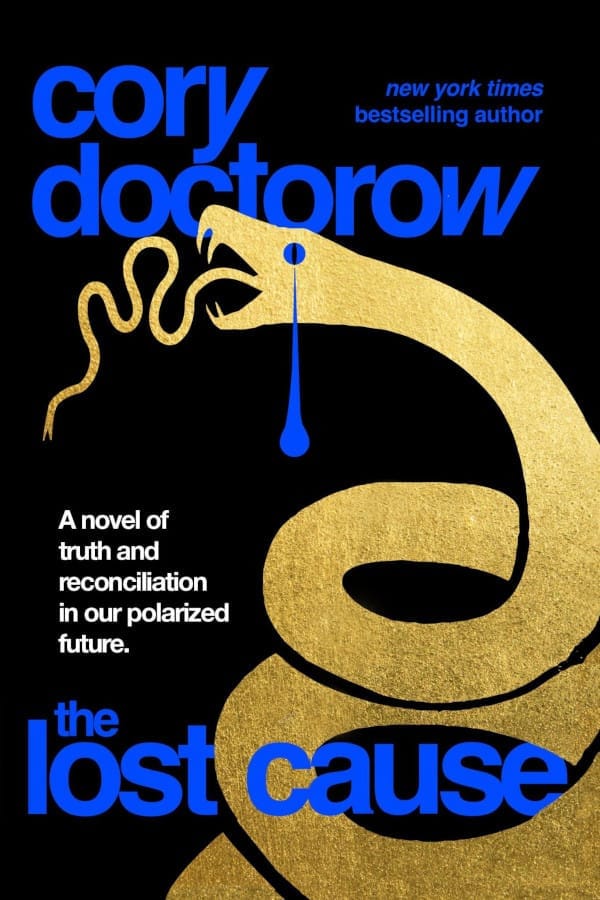
OK, doomer: A review of The Lost Cause by Cory Doctorow
Let’s talk about hope.
Some of the reaction to my reporting on the likes of the Atlas Network seems to be, roughly paraphrased, “We’re doomed.” This is perhaps understandable. Atlas and their ilk are well resourced, and are deeply embedded in cultural and media ecosystems. But it’s important to note that, in New Zealand, most of the policies and programs they espouse remain incredibly unpopular. Despite decades of effort and millions of dollars spent, the Act party struggles to crack 10 percent of votes. There is a growing awareness of the depth, breadth, and tactics of right-wing think-tanks, and it’s time to see what a truthful campaign against their decades of disinformation might look like. It’ll be hard work to de-entrench them, but it can – and must – be done. Doom isn’t good enough. We need to tell a true story, a better story, a story that builds hope. And it’s important to note that hope isn’t mere optimism; it is the motivating force for hard work and collective action.
On that note, let’s talk about some of the better stories that are already being told.
The Lost Cause
Much has been said about Kim Stanley Robinson’s The Ministry for the Future, some of it by me in this review at The Spinoff. It’s an extraordinary book, and I’m always on the lookout for more stories like it. When I saw that Robinson had blurbed Cory Doctorow’s new book The Lost Cause – “This book looks like our future and feels like our present—it’s an unforgettable vision of what could be” – I knew I had to read it.
I’ve been a fan of Doctorow’s blogging for long time. I’ve had a more varied relationship with his novels. I liked Little Brother, disliked Makers, and loved Walkaway once I realised that he was doing a kind of techno-anarchist inversion of Atlas Shrugged. It’s one of those books where characters will break into long philosophical treatises. (Those who advocate for bad ideas often wind up suitably chastised later in the plot.) Lefty Atlas Shrugged is a big challenge; it could easily have been a complete disaster, but Doctorow makes it both cheeky and effective. It helps that, unlike in Atlas, Doctorow’s characters are likeable and believable and the philosophical debates and treatises don’t usually run for more than a couple of pages.
The Lost Cause is my favourite work of Doctorow’s yet, because it takes his philosophical and ethical bugbears, mixes them with a notoriously difficult subject (climate change) in a particularly tricky setting (the very near future, as opposed to the distant future) and spikes the whole cocktail with the genuinely thorny question of what the hell are we going to do with all the people who caught brainworms? This isn’t something I’ve seen dealt with in fiction before; the deeply uncomfortable fact that no matter the direction history takes, most of today’s deranged Trump enthusiasts will still be with us in 15 or 20 years, only older and considerably more deranged.
In the world of The Lost Cause, this situation is tempered because somewhere between now and the near future some good, deeply necessary things happened: a progressive President got elected and actually started doing the needful on climate change. The book portrays this well; it’s mostly really hard (but really satisfying, meaningful) work. Robinson’s Ministry had a solid depiction of the sheer effort needed to address climate change but a lot of it was lofty, high-concept stuff – literally up in the clouds, in the case of the stratospheric aerosol-spraying geoengineering program undertaken by India. I loved all the big-think geekery in Ministry, but appreciated how The Lost Cause brings it down to earth. All of the high-concept cli-fi stuff – like a neo-neoliberal fleet of seasteaders who leech off the creaking remnants of global civilisation while preaching about liberty and freedom, in yet another nod to Atlas Shrugged – are seen through the literally and figuratively grounded eyes of lead character Brooks Palazzo, as in the following passage:
The Flotilla believed that some of us were born to be wise kings, and that winning in the market was the modern equivalent to pulling a sword out of a stone.
Brooks is a well-drawn character; a ball of energy bursting with queer joy, contrasted by a lifetime of trauma: first by the deaths of his parents in a vicious pandemic and then by living with his cruel, indifferent grandfather. The entire novel is suffused with the same almost manic energy that Brooks possesses, which is by turns inspiring and exhausting. I always get the feeling that Doctorow books are written fast (probably because they are – the guy wrote five books during the worst of the Covid-19 pandemic) and there’s a rawness and polemic fury to them that I deeply appreciate. It’s probably not for everyone, but it’s for me. Two quotes sum up the book well. The first acknowledges the deep-felt agony of not being able to do anything about the awful state of the world:
There is absolutely nothing worse than the sense that things are going wrong and there’s nothing you can do to fix them
And the second gives a sense of the antidote to despair.
I had arrived at a place of circulating abundance amid all of that tragedy and terror. Wherever I was, I could be happy, fed, surrounded by good people and hard work.
The Lost Cause achieves exactly what it sets out to do: it makes the gargantuan collective effort required to address climate change inspiring, interesting, and exciting. This is remarkable, considering the fact that attending local council meetings is a vital plot point. Another achievement worth noting is the novel’s commitment to non-violence. Robinson’s Ministry included a character who runs a black-ops division to carry out and fund highly effective acts of eco-terrorism, and the book implies that such will be necessary in the fight against climate change. The Lost Cause eschews that sort of thing entirely, and in fact seems to be in dialogue with Ministry and other utopian fictions like those of Iain M. Banks in arguing that violence against other people is counter-productive. While violence is a constant companion and threat in The Lost Cause – the book opens with a frightening would-be terroristic murder that ultimately ends in assassination – and while the characters consider taking up arms, the argument is always won by the proponents of non-violence. Against people, that is; violence against property is practically a given. Readers of How To Blow Up A Pipeline will find a lot to appreciate here.
Despite – or perhaps because of – its thorny, wide-ranging subject matter, The Lost Cause is excellent. It’s a great riff on utopia, and a cracking yarn. Its largest flaw is shared with Ministry in that the fraught, polluted, world-on-the-brink-ruin portrayed is a best-case scenario. Both books engage the conceit that at some stage, someone in power works to swerve the world away from the brink. From 2024, this seems almost impossible, but it’s never been more necessary. A willingness to do the needful on climate should no longer be a secondary consideration when it comes to choosing leaders; it needs to become the number-one prerequisite. This is ground that I hope a new cli-fi book will cover, but for now, The Lost Cause deserves to sit next to The Ministry for the Future in the emerging greats of the cli-fi canon.
The Lost Cause is published by Tor, but you can purchase a DRM-free copy direct from Cory’s website.

Undermined: How far right lobby groups push racist & reactionary agendas
A lot has happened in the last few days in the world of New Zealand’s neoliberal lobby groups and their political wings, and I’ve been trying to keep up with it all – but instead of writing it up here, as I usually would, I’ve been using it to prepare for a presentation I’m doing tonight as part of a free webinar. I’d love it if you could come along. Here’s the pitch from the organisers:
💡Join us for a webinar with journalist and researcher Josh Drummond. scholar-activist Tina Ngata and anti-colonial anti-fascist community organiser Sina Brown-Davis. The election of NACTNZ was fuelled by racist fear mongering, disinformation and imported culture wars from the US, driven by well-funded political organisations that pushed far right, white supremacist and free market economic ideas. Some of these ideas come directly from artificial grassroots organisations – nicknamed “astroturfs” – that are being used to manipulate and mobilise public opinion for political gain.For example, the Association of Community Retailers was in fact set up and funded by Imperial Tobacco to protest tobacco-related legislation. The Taxpayers’ Union is a member of the global Atlas Network that has celebrated member efforts to undermine the UN Declaration of the Rights of Indigenous Peoples and removing barriers to fossil fuel production. The Taxpayers’ Union claims that its campaign against Three Waters “led with the economics” but in fact its position opposing Māori co-governance was a leading feature.
The result is a far reaching political agenda that seeks to not only to roll back decades of work but to lock in a future dominated by the destructive death spiral of colonialist extractivism and violence.We must not only expose the activities, arguments and agendas of these organisations but effectively stop them if we hope to build a Tiriti-centred, climate just future for Aotearoa. Join us to learn, strategise and talk tactics.
The event is free – register here now.
You know what isn’t free but would give my work a really great boost? A paid subscription. If you value what I do, get amongst it here:
Sign up for The Bad Newsletter
A newsletter about news media, think tanks, and climate change.
No spam. Unsubscribe anytime.

The Rub
The ACT Party’s attempt to neutralise New Zealand’s founding document, Te Tiriti o Waitangi, has not started well. The far-right, ultra-neoliberal party, emboldened by the defeat of Australia’s Indigenous Voice referendum – thanks largely to a campaign orchestrated between dark-money-funded, far-right think-tanks and the Murdoch media – has Te Tiriti in its sights. The result? More than 10,000 people attended a hui at Turangawaewae Marae to declare, collectively: hands off Te Tiriti.
There are some great write-ups addressing the hui’s significance. This, by Newsroom‘s Aaron Smale, is fantastic:
The Crown’s invasion of Waikato, and the violence, death and dispossession that followed were all instigated on the same premise – Māori were getting too big for their boots and needed to be taught a lesson. The lesson always seemed to involve the loss of land and resources but also the loss of any kind of independent power. The Crown was not ‘just’ taking land – it was rearranging the terms of engagement. It was usurping power.
John Campbell and Mihingarangi Forbes also have excellent write-ups.
Of course, media are also giving near endless space to ACT leader David Seymour to advance his arguments for his proposed Treaty principles bill. Despite the fact that his statements on the Treaty and the effects of his party’s proposed bill span a spectrum from specious to ahistoric to false, they’re rarely checked or disputed when he makes them. His disinformation is also couched in language like “fairness” and “rule of law” and “not discriminating on the basis of race” – concepts that no-one opposes, which has the effect of making his disingenuousness appear ethically watertight. But it’s not, and never has been. There is nothing fair in re-writing a treaty that was almost immediately broken and then dismissed as a “nullity”, only to be given reluctant, limited recognition almost a century later. There’s no rule of law in a system that sees Māori imprisoned at twice the rate of Pakeha for the same crimes. (To be fair to ACT, there is plenty of discrimination on the basis of race in New Zealand, but practically all of it is to the benefit of Pakeha.)
Seymour’s prevarication is expected, as someone whose career was born and bred for years in a series of murky Atlas Network think-tanks (Seymour’s real-world work experience is around ten months work as an electrical engineer.) What’s interesting is that the major think-tanks one would expect to play a major role in an attack on Te Tiriti have been – since the hui – mostly silent. Don Brash’s Hobson’s Pledge has, at the time of writing, said nothing. The reliably mask-off NZCPR’s last post is a piece that wishes members Merry Christmas.
💩Deeply annoying update: Hobson’s Pledge updated their website overnight (after this newsletter was finished and scheduled), with a fundraising drive based almost entirely on the hui. The content is mostly the usual Brash bullshit about “Māori separatists” and peddling his thoroughly discredited, ahistoric take on Te Tiriti, claiming that the treaty was a cessation of sovereignty. (It wasn’t.) But the rhetoric is wilder and more frantic than usual. “We either fight for an equal and unified New Zealand now or watch this beautiful country continue to slide into a race-based caste system,” Brash all but screams. “We owe it to our children and grandchildren to ensure that the battle for our democracy is won.”Add that to Trotter’s and Hooton’s takes (detailed below) and it looks like three strikes for war metaphors. This is horrific, dangerous rhetoric, but I can’t see them stopping.
Of course, the think-tank adjacent opinionists are still opining. NZCPR’s “Breaking Views” blog is a round-up of reactionary opinion from throughout NZ, and it’s enlightening, in a backwards way. Climate change denier Richard Treadgold, founder of miniature think-tank “Free New Zealand,” has a bit that begins by calling Māori words juvenile, progresses rapidly to cannibalism, and gets worse from there. Sandra Goudie, former National MP and former anti-vax mayor of Thames, is there with a bog-standard piece of Treaty denial that insists that the “principles of the Treaty” don’t exist and that the Treaty doesn’t actually count because “the first real constitutional document was Queen Victoria’s Royal Charter of 1840 establishing New Zealand as a separate British Colony.”
The darkest – and by far the weirdest – response is by Chris Trotter, writing at Bryce Edward’s Democracy Project. He’s not a think tank guy but it’s worth mentioning, because his take is cooked to the point of being 0n fire: the column is an extended fantasia about an imminent actual shooting war between Māori and Pakeha:
As the bicentenary of the signing of Te Tiriti looms ever nearer, the Pakeha settler state faces two, equally unpalatable choices. It will either have to accede to a Māori-led constitutional revolution, or find its own, twenty-first-century equivalent of General Cameron. A Pakeha military leader prepared to shove back harder than the movement for tino rangatiratanga can push.
This is the sort of thing best dealt with by backing away slowly and avoiding eye contact. It’s useful only in that looking at what the weirdo commentariat is churning out might provide clues as to the direction that the think-tanks’ inevitable public campaigns might eventually take. What’s more helpful is to remember what’s actually driving all this. It’s happening for the same reason far-right think-tanks have taken aim at indigenous rights all over the world.
“The last Government quietly paused oil and gas exploration,” is an article by the excellent climate reporter Olivia Wannan at Stuff. The reason cited for the fossil fuel exploration pause is, of course, indigenous rights.
As revealed in an Official Information Act response, Woods’ decision came after a hui (meeting) in January 2022 with eight iwi groups. The leaders asked for a pause on permits, so they could better focus on consultation about how the country will transition away from fossil fuels.
Some activists warn the Government could be in breach of The Treaty of Waitangi (Te Tiriti o Waitangi) if it ignores the request before issuing onshore and offshore exploration permits.
And there’s the rub. To put it very simply: indigenous rights (potentially) stand in the way of what colonist corporations see as their unfettered right to enclose land and dig stuff up for profit. It’s always been like this. Let’s return to Newshub’s Alan Smale:
The Land Wars happened because the Crown would not tolerate being told Māori were not going to sell. But it framed this as a rebellion against its (imagined) authority. The initial impetus for this conflict occurred when the Crown wanted to buy a piece of land from an individual in Taranaki. The senior leader of the iwi in Waitara, Te Rangitake, refused to recognise the sale as the land was collectively owned in line with Māori tikanga. The Crown sent in the troops to force the sale. The rest, as they say, is history.
That’s why the far-right think-tanks fight both climate change measures and indigenous rights with equal alacrity – they’re terrified of what happens if indigenous people finally get given a real say about what happens on the land they never ceded to colonists.
💡Update!Looks like I missed another race-war alarmist in the reliably unreliable Matthew Hooton. An opinion piece by AUT University chair Rob Campbell in Newsroom reports:
[Hooton] pondered a “full-on confrontation” with “Māori activists” and numbered up police and military strength noting that “it wouldn’t take much for law enforcement to be overwhelmed”.
That’s two! Peddler of imperialist derring-do Ian Fleming had this to say about things that happen twice: “Once is happenstance. Twice is coincidence. Three times is enemy action.” It’ll be interesting – in a bad way – to see how the “just asking questions about our military capacity in the event of an actual civil war” narrative pans out, and whether that’s one that the think tanks will eventually run with. I hope not, but I expect to be disappointed. The above opinion piece is well worth reading, not least since it shouts out to our friends the Atlas Network. I never stop being happy to see that all-encompassing, media-hacking, neoliberal vampire squid named in the news.
For an article about what Māori are actually up to outside of the imagination of past-it Pakeha columnists, check out Nadine Anne Hura’s fantastic article, “Five climate lessons from Māori communities (that are guaranteed not to depress you).”
Today In (Keeping) Tabs (on the Think-Tank /Media Confluence)
Apologies to Today In Tabs for the headline, but thank you to Today In Tabs for the shout-out to my last piece, All The Garbage I Found On Substack In One Hour.
The New York Times has an incredible expose on “anti-woke” activism targeting American universities that omits only one crucial factor: the outsize role played by the New York Times in “anti-woke” activism targeting American universities. To recap: a media feeding frenzy on allegations of plagiarism made by openly mendacious think-tank employees led to Harvard President Claudine Gay’s resignation. Despite being warned repeatedly that they were being conned by a right-wing hit-job, the Times ran article after article after article. In the end it didn’t matter that the “plagiarism” Gay committed amounted to not plagiarism:
In some works, Gay credits a source in the wrong sentence. In others, she borrows language that even those who were ostensibly plagiarized accept as common phrasing within their field of study. “I am not at all concerned about the passages,” said the political science professor David Canon, whose work the Washington Free Beacon accused Gay of plagiarizing. “This isn’t even close to an example of academic plagiarism.”
I’ve never managed to get my head around this fundamental weirdness – news media seem completely ignorant of the role they play in shaping perception on all kinds of issues, to the extent that it must be deliberate. I guess that’s why this newsletter exists!
The Times story does a good job at identifying the think-tanks driving the the anti-DEI, anti-woke discourse, but it fails to point out that the three main think-tanks mentioned – the Claremont Institute, the Manhattan Institute, and the American Principles Project – are all past or present members of the Atlas Network. This is another inexplicable failing; you’d think that when examining a concerted attack on academic freedom, you’d at least mention the single largest common denominator.

All the Garbage I Found On Substack In One Hour: An Update
Content warning
This post contains examples of rampant anti-Semitic hate speech, Nazism, white supremacy, some of the worst and weirdest anti-science/anti-vax stuff I’ve seen anywhere on the Internet, anti-trans hate speech, and Glinner. Read at your own risk. Have a shower ready.
It started with a story recommended by Substack itself. Through a bit of judicious user tracking and algorithmic filtering, Substack have divined that I’m interested in “Climate & Environment.” They’re right. In their app and web interface, Substack recommend the top five newsletters in this category. One day a few weeks ago, the number two slot caught my eye. It was plugging a “Dr. Simon,” and I found it interesting because the headline seemed to suggest that the Doctor wasn’t writing conventional climate news. In fact, it seemed to be at right-angles to observable reality.
The headline was “Are We Losing the War for Freedom to the Great Reset?”
The “Great Reset” is a conspiracy theory which can trace roots, as so many conspiracy theories can, to the antisemitic “Protocols of the Learned Elders of Zion” hoax. It is a relation of the Great Replacement conspiracy that has inspired many acts of terrorism, including the Christchurch mosque massacre. The BBC puts it bluntly:
A vague set of proposals from an influential organisation has been transformed by online conspiracy theorists into a powerful viral rallying cry. What is the truth behind the “Great Reset”?
Believers spin dark tales about an authoritarian socialist world government run by powerful capitalists and politicians – a secret cabal that is broadcasting its plan around the world.
I was surprised to see Great Reset content recommended in the “Climate and Environment” category, so I clicked through.
It was worse than I’d expected.
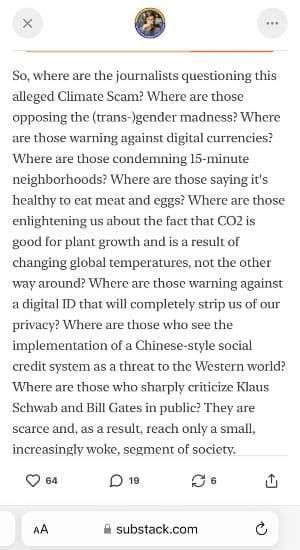
From that screed, and the rest of his content, it’s very easy to see that Dr. Simon is a disinformation newsletter. That paragraph is a grab-bag of conspiracy theories, disinformation, and hate speech. Let’s count them: we have (1) climate change denial, (2) anti-trans hate (3) “digital currency” spooking (4) “15 minute neighbourhoods,” a perfect example of an entirely benign urban planning concept transformed into conspiracy, (5) off-kilter diet claptrap — a lot of conspiracists are obsessed with diet and nutritional purity (6) more climate change denial; CO2 is only good for plant growth up unto a certain point and increased heat and weather variability is *not* good for many plants, including crop species, and its increase in recent times is a result of human activity (7) “digital ID” scaremongering and (8) Klaus Schwab and Bill Gates.
Nearly all of Dr. Simon’s content is like this. All nonsense — and some of it dangerous to the point of being life-threatening, if readers were to take his disinformation about Covid and vaccines seriously.
All of it is enabled and monetized by Substack.
From his About page, I can see Dr. Simon has “11K+ subscribers.”
I can also see the newsletters he recommends, which gave me an idea. What if I spent an hour going down a recommendations rabbit hole, seeing just how much of this stuff was on Substack?
So that’s what I did. I set a timer for sixty minutes, and got to work.

The first of these is unremarkable. You’re The Voice, a Substack newsletter that also utilises Substack’s podcast and video platform, is only interesting in how it manages to make conspiracies utterly boring. Its wooden prose and unremarkable headlines mask the usual conspiracism about “globalists” and “global agendas.”
We’ll discuss global agendas; Covid/climate/15-min cities/money/agenda 2030 & touch on the war in Israel…
Sounds riveting! It has “3K+ subscribers.”
Dr. Simon also recommends Outspoken by Naomi Wolf. Wolf’s journey from respected author to a conspiracy and disinformation queen — banned by Twitter in 2021, newly beloved by the likes of Steve Bannon — is well known, thanks largely to the work of real journalist Naomi Klein in her 2023 book Doppelganger. Wolf doesn’t seem to be taking it well. This is her pinned post:
The rest of Wolf’s Substack is the usual wild disinformation kaleidoscope of Covid conspiracies, anti-vax untruth — in her posts, Wolf often lies about vaccines, with special attention paid to the mRNA-based Covid vaccines — and howling about “globalist oligarchs.”
Wolf has 81K+ subscribers on Substack.
Let’s move on to another doctor: Dr Sam Bailey! This Substacker bills herself as “the medical establishment’s worst nightmare.” Given her content, it might be true. Bailey, who is a former GP from Christchurch, is best known for appearing before New Zealand’s Health Practitioners Disciplinary Tribunal for producing Covid-19 disinformation on YouTube. She’s since stopped doing so, and she explains why, in a pinned video.
“After some reflection, I decided to take all of my videos about Covid-19 off YouTube, and I won’t be posting Covid-19 content on here any longer,” Bailey says. Her reason? YouTube was removing her videos due to their high disinformation payload.
Luckily for Dr. Bailey — and unluckily, for the “medical establishment,” whose worst nightmare she apparently is — she swiftly found a new, monetized home for her Covid-19 content on Substack.
Here’s a sample of what she’s selling:
Many of the older guard anti-vaxxers used historical data to conclusively demonstrate that vaccines cannot possibly be the cause of the vast decrease in sickness and death from many diseases. Now there is a new wave of anti-vaxxers in the tradition of Dr Stefan Lanka who continue to refute not only virus existence but also the wider concept of pathogens. This “upstream” line of reasoning brings down the entire notion of vaccination permanently.
Vaccines are being exposed on multiple fronts as more people wake up to one of the biggest swindles in history. Is it now time to embrace the “anti-vax” label?
Bailey doesn’t just lie about the Covid vaccine; she lies about all vaccines. And she doesn’t merely deny the effectiveness of vaccines; she denies that viruses exist.
Dr. Sam Bailey is a virus denier.
Dr. Sam Bailey has 16K+ subscribers on Substack.
Let’s check out Dr Simon’s next recommendation: Vigilant News, by The Vigilant Fox.
It’s… a lot.
Substack has introduced a tool for writers that lets writers recommend publications, or lets different newsletters “blurb” each other. Let’s see what user “The Farm” of The Farm newsletter has to say of The Vigilant Fox.
“The Vigilant Fox is one of the single best citizen journalists we have standing up for freedom from the tyrannical sociopaths that are trying to destroy our way of existence.”
– The Farm, The FarmOkay then! What’s The Farm all about?

“The Rape of the Mind,” followed by screeds about Ivermectin? That’s enough. Let’s return to The Vigilant Fox. At the end of his pinned article, a long ramble of virulent disinformation about Covid vaccines entitled “The Unvaccinated Will Be Vindicated,” he has this to say:
I am proud to announce that I have left my day job to become an independent reporter! If you want to help keep this operation afloat, consider becoming a free or paid subscriber.
The Vigilant Fox has 49K+ subscribers on Substack.
My timer is getting close to 30 minutes and I’ve barely scratched the surface of one Substacker’s recommendations. Let’s have a look at Kanekoa News.
Let’s stop looking at Kanekoa News. It’s just more of the same disinformation.
Kanekoa News has 64K+ subscribers on Substack.
At this point I’m growing tired of looking at Dr. Simon’s recommendations. The several Substacks he recommends all have their own recommendations, which have their own, and so on, seemingly forever. Almost all of them appear to be some kind of anti-vax disinformation, or science denial, and many have subscribers in the thousands or tens of thousands. All the ones I look at appear to be monetized. Many sing the praises of Substack for giving them a home after being hounded from other platforms.
So I turn to Bing to see if I can plumb the depths of Substack’s Nazi problem, as written about by journalist Jonathan Katz. (I’d use Google, but the giant search engine seems to have decided that helping its billions of users easily access overtly Nazi content is bad for society.)
I search for the most obvious, basic stuff. “Nazi Substack.” “National Socialist Substack.” “White power Substack.”
I find it, easily.
Let me introduce you to Karl Haemers, author of the newsletter Taboo Truth. Haemers describes himself as a “Researcher, author, secular End Times alarmist, race realist, revisionist, human.” What’s he got to say?
This article is a vile diatribe against Jews and how best to propagandise against them. It contains the following quote:
I refer back to Goebbels’ diary quote, which rather says that Whites’ intelligence has been used against them, and our instincts have been subverted by our very intelligence twisted by the Jews.
So yeah, Karl Haemers is a Nazi.
He’s got over 700 subscribers, and — at the time of writing, post Substack’s decision to purge a mere five Nazi newsletters — he’s still monetized.
A little snippet of Substack code under Haemer’s profile says “Timothy Kelly and 100+ others subscribe.”
Who’s Timothy Kelly?
He has a paywall on, but the article snippets in his archives are… enlightening.

So yeah, he’s a Nazi.
None of Timothy’s articles appear to be free, so we can reasonably assume that of his subscribers, the majority are paid, or they’re unable to read anything he writes. His Substack-enabled subscription plans start at $8 NZD per month. I counted his subscribers, and he has 258. That means that this Nazi is earning in the ballpark of $2000 NZD per month — more, if any of them are “founding members,” the price per which starts at $385 per year.
Next, I find The Imperium Press, which is one of those infuriating white supremacist newsletters that — to paraphrase Ken White — is not even occasionally terse. It goes on, and on, and on, in a maddening pseudo-intellectual vein. But eventually we come to the rub:
These are only a few of the shapes that this default state can take, what Houston Stewart Chamberlain has called the Aryan Worldview. To call it merely “right-wing” is to trivialise it. We call it folkishness.
I call it Nazi.
The Imperium Press has 3k+ subscribers on Substack, and — of course — they’re monetized.
Similarly, the Fascio Newsletter, another Substack I found effortlessly via Bing, is about what they call “Third position politics,” and which is more accurately called neo-fascism. Their entire Substack can be filed as a classic of the “no we’re not fascists, we’re just really really really interested in fascism, and also we agree with a lot of fascism” genre. Their swathe of authors make it difficult to tell exactly how many subscribers they have, but a Substack popup prompting me to subscribe says they have “Over 1,000 subscribers.” They are (of course!) monetized. (The individual writers who comprise Fascio have “2K+ subscribers” each — whether this is individual or as a collective is unclear.)
Jonathan Katz’s Atlantic article also mentions White-Papers. What’s their deal?
At White-Papers, our core premise is that White people, the European race, deserves its own voice, its own political institutions and a future free from interference or predation by outside groups. Whites are a global minority and are now becoming minorities in their own homelands. The inevitable and necessary result of this is a growing political movement of explicitly pro-White news outlets, publishers, and political pressure groups.
So yeah, they’re white supremacists. The little Substack popup that urges me to subscribe says they have “Over 1,000 subscribers.”
By the end of my hour, it’s clear that there are many, many, many more of these Substacks. Too many, in fact, to list, varying in position from “just really enthused about fascism” to quite overt Nazis. Many — seemingly most — are monetized. Some appear to have paid subscribers in the hundreds; a feat many Substack newsletters (including The Bad Newsletter!) never achieve, and which can produce either a tidy living or very useful source of funds for your movement.
In short, there are lots.
I’d like to stop there, but the worst is yet to come. And this one I didn’t find myself. It found me.
When I posted my version of the open letter Substackers Against Nazis, a commenter showed up with a lengthy screed that used the anti-Semitic slur “kikes.” The author seemed to be searching for Substacks that had posted the open letter and was railing against them. Curious, I clicked on the commenter’s name and found the most overtly Nazi newsletter yet. This one wasn’t hiding behind faux-intellectual essays on Third Positionism, or even trumped-up concern for the “White Race.”
It was this.

This Substack, Nordic Pagan Soldier, is raw, unadulterated Nazism. Much of its content is elaborations on the literal Protocols of the Learned Elders of Zion. One post is written in Hindi; translated, it is vile slurs about Jews and Muslims from beginning to end.

The author’s recommendations for other newsletters run the gamut from Putinist propaganda to an anti-Semitic Qanon podcast (hosted via Substack’s convenient video and podcasting tools). His “Reads” list is extensive — a huge list of conspiracist authors of various stripes. Oh look, Edward Snowden is there too!
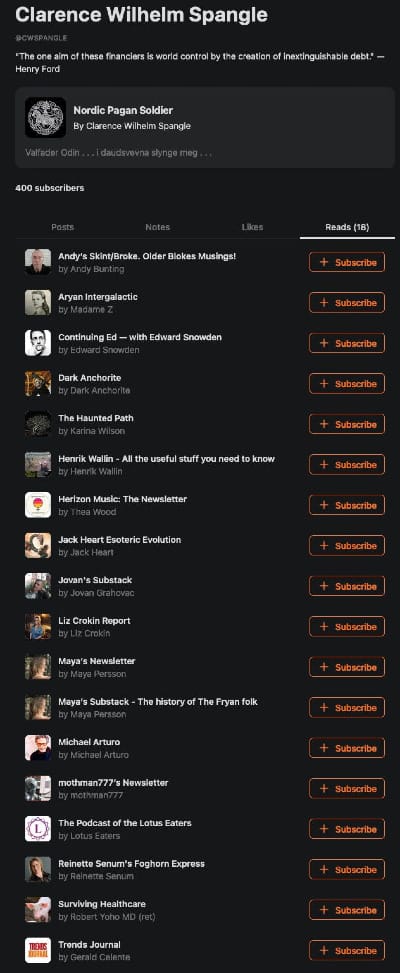
When you subscribe to this Substack, you’re sent a montage of explicitly anti-Semitic text and propaganda posters — put into jpeg form, it seems, as not to trigger spam filters. Don’t worry, the Substack mail always gets through.
Nordic Pagan Soldier has 500 subscribers.
The author hasn’t turned on paid subscriptions. “I DO NOT NEED THE MONEY AND I NEVER ASK FOR IT,” he says, verbatim.
But Substack, not to be deterred from a revenue opportunity, offers users the chance to “Pledge their support,” just in case this Nazi ever decides to monetize.

“Join the crew,” Nordic Pagan Soldier urges readers. “Be part of a community of people who share your interests… To find out more about the company that provides the tech for this newsletter, visit Substack.com”
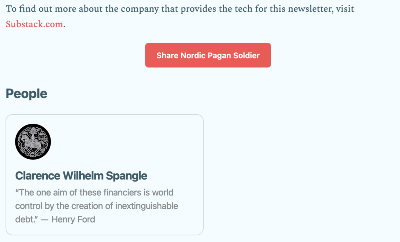
This content, and the other things I’ve covered — found either via minimal-effort searches or Substack’s network of recommendations, or (in one instance) a Nazi commenter just kind of announcing themselves on my newsletter — is the tip of the tip of the iceberg. In fact, “iceberg” is being a bit too nice. This is a garbageberg; a disgusting collection of the worst disinformation and filth. It’s like if 4chan and 8chan and Kiwi Farms offered a cutely-monetized email subscription option. It gets worse: I haven’t even mentioned the larger disinformation spreaders, as covered by the Washington Post.
This type of content is “so bad no one else will host it,” said Imran Ahmed, CEO of the Center for Countering Digital Hate, a nonprofit that focuses on combating misinformation and has researched Substack. By splitting subscription profits with creators, the group estimates, Substack generates at least $2.5 million a year in revenue from just five anti-vaccine leaders who have amassed tens of thousands of subscribers, each paying $50 a year.
The publications I’ve listed above — which seemingly represent a very small slice of Substack’s disinformation ecosystem and which I was able to discover in just one hour of work — boast 231,485 subscribers between them, by my count. Almost a quarter of a million people. If we assume a fairly standard proportion of these subscribers are paid (let’s say 10 percent) and assume they charge $8 NZD per month each, that’s $185,189 NZD a month — more than $2 million a year in revenue to the disinformers, and a non-insignificant $222,226 annually to Substack, via their 10 percent cut. Add that to the millions Substack makes from the biggest liars (as per the Washington Post) and it’s clear that disinformation of all kinds is a huge market for Substack.
In fact, it makes me think Substack might be primarily a disinformation ecosystem — with a bunch of credible writers bolted on, to be the acceptable public face of a company that exists mainly to monetize the internet’s limitless supply of garbage.
I did the research and early drafting for this article several weeks ago. I sat on it, hoping that Substack would ban — at least! — the overt white supremacist and Nazi publications. I hoped that the disinformation newsletters might get demonetized.
At the time of writing, all the publications I found in my hour of research were still active. They seem keenly aware of the controversy around their content, and they’re cheering on Substack, who they clearly see as an ally. Don’t take my word for it: here’s Nazi newsletter Taboo Truth:

Like too many other users of Substack’s Twitter clone, Notes, Taboo Truth’s favourite thing after fascism seems to be posting graphs of his subscriber numbers.

I’d like to find out more, but this is all I can manage for now. I do all this in my spare time, and yet it’s clear more research is needed. I hope someone who has more than a few hours to hand can do it. If I had time to accurately quantify my opinion that Substack is a significant player in the world’s disinformation ecosystem, I’d start by getting a list of all the websites that live on the .substack.com subdomain, identifying which had more than 100 subscribers, and running a mechanical turk-powered content analysis to see which are disinformation, TERFs, Nazis, or similar. It’d be a big job. Sadly, it seems that unless Substack opts to proactively inform the public about the role it plays in spreading disinformation, that’ll be the only way we’ll find out.
I want to close with an apology. I really liked Substack. It gave me the chance to write what I like and have my work seen: something every writer wants. I was enamoured to the point of inviting several friends to the platform — some of whom became quite big publishers. But in doing so I ignored the voices of critics, including trans people, who pointed out how Substack had purposely recruited prominent TERFs to the platform, to spread their particularly cruel form of contagious disinformation against some of the world’s most vulnerable communities.
People like Glinner.
Of course, he’s still on Substack.
“Beloved internet personality” Here’s Glinner on his “About” page — probably one of the first things he wrote on joining Substack — indulging in the usual transphobia, denigrating those who’ve chosen surgery to help with gender dysphoria, and falsely insinuating that trans activists are coming to mutilate children.
It was only children who needed to place themselves on those hospital trolleys. As Alex Drummond famously said ”The thought of surgery terrifies me”, and as Magdalen Berns famously replied, “Of course it terrifies you, Alex. They chop your cock off.”
This sort of thing is horrible. But it’s been part and parcel of Substack since the beginning.
Until now, we just chose not to notice.
Post-Ghost Update
One thing I regret not mentioning in the original article is that there is a common theme in Substack’s taxonomy of garbage content: transphobia. The Q conspiracists are transphobic, the Covid cranks are transphobic, the Islamophobes and the anti-Semites and the white supremacists and the overt Nazis are transphobic. (Perhaps needless to say, Glinner and his fellow TERFs are transphobic.) Transphobia is, almost invariably, the one thing that binds them all. I find that very telling, and deeply worrying.
What’s more, the sheer depth and breadth of Substack’s disinformation ecosystem is becoming more and more apparent. An author whose work I enjoy, Melanie Newfield, pointed out that Substack has thoughtfully provided a really easy way to find medical disinformation: the “health politics” filter in its prominent “Explore” tab. How bad is it? Really bad:

These disinformation newsletters include some of the biggest Substacks of all. In February 2023, the Press Gazette reported that many of the highest-earning Substack newsletters were health disinformation:
The analysis affirms previous reporting suggesting Substack has become a lucrative revenue stream for writers with fringe views. For example, Covid-19 vaccine sceptics Robert Malone, Steve Kirsch, Alex Berenson and Joseph Mercola all appear among the most lucrative Substacks.
Each of these newsletters, the Press Gazette estimated, could have earnings anywhere between $500,000 and a colossal $4,999,950, every single year. And this was before Substack launched many of its network growth features, so those figures could be even greater by now. By any count, the named writers are getting rich from spreading disinformation, and so is Substack, via its tidy 10 percent cut of all author earnings.
It seems clear that this is why Substack doesn’t want to “censor” transphobia, conspiracies, health disinformation, and even Nazis (despite being perfectly happy to ban porn: you can’t do sex work on Substack). It’s not about free speech: it’s because they’re making far too much money from all of it. It really looks like spreading disinformation is the cornerstone of their business, and that’s not something I’m prepared to support.
Sign up for The Bad Newsletter
If you want to support my work (either free or paid) with the assurance that none of your money is going to Nazis, you can do so here.
No spam. Unsubscribe anytime.

